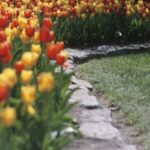Container landscaping ideas have become increasingly popular for both small and large outdoor spaces. This article explores the concept of container landscaping and its numerous benefits, providing tips for choosing the right containers, selecting suitable plants, arranging the layout, and maintaining the greenery throughout the seasons. Whether you are new to gardening or a seasoned pro, this article offers insightful advice and creative ideas for creating beautiful and functional container landscapes.
The use of containers in landscaping allows individuals to add greenery to any space, regardless of size or location. From balconies and patios to front porches and urban rooftops, container landscaping provides an opportunity to bring nature into your surroundings. This article delves into various aspects of container gardening, offering inspiration for everyone looking to enhance their outdoor living area with lush foliage and colorful blooms.
In this comprehensive guide, readers will find valuable information on selecting the right containers and plants for their specific needs and preferences. Additionally, this article covers design and layout tips for creating visually appealing displays that complement the overall aesthetic of any space.
Furthermore, maintenance advice is provided so that individuals can keep their container gardens flourishing all year round. Whether you are interested in traditional gardens or prefer unique designs such as vertical gardens or hanging baskets, this article has something to offer for every type of container gardening enthusiast.
Container Selection
When it comes to container landscaping ideas, choosing the right containers is essential for the success of your plants. The following tips will help you select the perfect containers for your space and plants:
- Size: Consider the mature size of the plants you intend to grow and choose containers that provide enough room for their roots to spread. Small plants can thrive in smaller containers, while large or spreading plants will need larger containers.
- Material: Containers come in various materials, including terracotta, plastic, wood, metal, and ceramic. Each material has its own advantages and disadvantages, so consider factors such as durability, weight, and insulation when making your selection.
- Drainage: Proper drainage is crucial for container gardening success. Look for containers with drainage holes to prevent waterlogged soil, or be prepared to drill holes in the bottom if necessary.
Additionally, consider the style and aesthetic of your outdoor space when choosing containers. Selecting containers that complement your existing landscape design will create a cohesive and attractive look.
Ultimately, the right container will provide a stable environment for your plants to grow and thrive. By considering factors such as size, material, drainage, and style, you can ensure that your container landscaping ideas come to life in the best possible way.
Plant Selection
When it comes to container landscaping ideas, choosing the right plants and flowers is crucial for creating a stunning and thriving display. The key to successful container gardening is selecting plants that will not only complement each other but also thrive in the conditions of your specific location. When choosing plants for your containers, it’s important to consider factors such as sunlight exposure, climate, and the overall aesthetic you want to achieve.
One of the best things about container gardening is the versatility it offers when it comes to plant selection. You can combine different types of plants with varying colors, textures, and heights to create an eye-catching and dynamic display. For sunny spots, consider vibrant and low-maintenance options such as petunias, geraniums, or marigolds. If your space gets less sunlight or if you’re looking for foliage options, plants like ferns, hostas, or coleus can thrive in shadier conditions.
| Plant | Growing Requirements |
|---|---|
| Petunias | Full sun; regular watering and well-drained soil |
| Ferns | Partial to full shade; consistent moisture and high humidity |
| Geraniums | Full sun; well-draining soil; deadheading for continued blooms |
Design and Layout
Utilize Different Heights and Sizes
One way to create an interesting container landscaping display is to play with varying heights and sizes of containers. This can add visual interest and depth to your arrangement. Taller containers can be placed at the back, while shorter ones can be in the front. Additionally, mixing different sized containers will add dimension to your overall design, giving it a more dynamic look.
Consider Color and Texture
When arranging your containers, consider the color and texture of both the plants and the containers themselves. For instance, you can create a cohesive look by using containers of similar colors or materials. On the other hand, if you prefer a more eclectic look, you can mix and match different container styles for an eye-catching display. Remember that foliage isn’t the only source of color – many colorful pots are available as well.
Create Focal Points
Incorporating focal points into your container landscaping design can help draw attention to specific areas. The use of eye-catching plants or unique containers as focal points can help create visual interest within your arrangement. Consider placing these focal points strategically within your layout to guide the viewer’s eye through the space.
By implementing these design tips, you can easily create a visually appealing container landscaping display that will enhance any outdoor space. Whether you prefer a cohesive look or something more eclectic, there are numerous ways to arrange your containers for an attractive and functional landscape design.
Maintenance
When it comes to container landscaping ideas, maintenance is a crucial aspect to consider for the health and growth of your plants. Proper watering, fertilizing, and overall care are essential for ensuring that your container garden thrives. Here are some tips for keeping your plants in containers healthy and vibrant:
- Watering: The key to successful container gardening is to water your plants regularly. Check the soil moisture daily, especially during hot summer months. Water when the soil feels dry to the touch, but avoid overwatering which can lead to root rot.
- Fertilizing: Unlike plants in the ground, those in containers have limited access to nutrients. Use a balanced liquid fertilizer every two weeks during the growing season to provide your container plants with the necessary nutrients for healthy growth.
- Choosing the right soil: Opt for high-quality potting mix specifically formulated for container gardening. This type of soil provides good drainage and aeration for healthy root development.
Caring for plants in containers also involves monitoring their growth and making adjustments as needed. Regularly inspect your plants for any signs of pests or diseases, and promptly address any issues you may notice.
In addition to proper watering and fertilization, it’s important to routinely prune and deadhead your container plants as needed. This helps promote new growth and keeps your displays looking tidy and well-maintained. By staying attentive to the needs of your container garden, you can enjoy beautiful, thriving plants throughout the growing season.
Seasonal Ideas
Container landscaping is a versatile way to bring beauty and greenery to any outdoor space, regardless of the season. By switching out plant varieties and utilizing seasonal decor elements, you can create stunning container arrangements that change with the time of year. In the following sections, we will explore some creative container landscaping ideas for each season, including summer, fall, winter, and spring.
In the summer months, vibrant blooms and lush foliage can thrive in containers. Consider using heat-tolerant plants such as petunias, salvias, and ornamental grasses to create a colorful display. You can also incorporate trailing vines or cascading flowers to add a touch of whimsy to your containers. Additionally, consider adding outdoor-safe decor elements like lanterns or colorful cushions to complement your summer container landscaping.
As autumn arrives, transitioning your container landscaping to reflect the changing colors of the season can create a stunning visual impact. Look for plants with foliage in shades of red, orange, and yellow such as mums, ornamental kale, and pansies. To add an extra dimension to your fall containers, consider incorporating decorative items such as pumpkins or gourds alongside seasonal blooms. This will create a warm and inviting atmosphere for your outdoor space during the fall months.
During the winter season, it’s important to choose plants that can withstand cooler temperatures and even frost. Evergreen shrubs like boxwood or juniper provide structure and color throughout the colder months. You can also incorporate seasonal accents such as pine cones or berries for added interest in your winter containers. Consider using lights as part of your container landscaping design to add a festive touch during the holiday season.
Lastly, as spring emerges with its fresh burst of growth and color you have numerous options for creating beautiful container displays. Consider planting bulbs like daffodils or tulips along with early-blooming annuals such as pansies or violas for a cheerful springtime look in your containers. Incorporating seasonal-themed decorations like Easter eggs or garden flags can further enhance the charm of your spring container arrangements.
| Season | Ideas |
|---|---|
| Summer | Heat-tolerant plants (petunias), trailing vines/cascading flowers; Outdoor-safe decor elements (lanterns) |
| Fall | Foliage in shades of red/orange/yellow (mums); Decorative items (pumpkins/gourds) |
| Winter | Evergreen shrubs (boxwood/juniper); Seasonal accents (pine cones/berries); Lights for holiday season |
| Spring | Bulbs (daffodils/tulips), early-blooming annuals (pansies/violas); Seasonal-themed decorations (Easter eggs/garden flags) |
Creative Ideas
Container landscaping doesn’t have to be limited to traditional potted plants on a porch or patio. There are many unique and creative container landscaping ideas that can add visual interest and intrigue to any outdoor space. From vertical gardens to hanging baskets to terrariums, these innovative concepts can elevate the aesthetic of your landscape while maximizing limited space.
Vertical Gardens
Vertical gardens are a great way to make use of vertical space in small outdoor areas. By utilizing wall-mounted planters, trellises, or specially designed structures, you can create a lush and vibrant display of plants and flowers that adds depth and dimension to your outdoor environment. Whether you opt for flowering vines, cascading greenery, or a mix of both, vertical gardens can transform an ordinary wall into a living work of art.
Hanging Baskets
Hanging baskets are an excellent option for adding color and visual appeal to porches, balconies, or pergolas. These versatile containers can hold a variety of plants, from trailing blooms to lush ferns, and can be easily moved around as needed. With the right selection of plants and strategic placement, hanging baskets can create a beautiful overhead canopy of greenery that provides shade and ambiance.
Terrariums
Terrariums offer a unique way to showcase small-scale landscapes within glass containers. These miniature ecosystems can be filled with an assortment of plants, mosses, rocks, and other natural elements to create captivating displays that are both low-maintenance and visually intriguing. Whether displayed on tabletops or as part of a larger container garden, terrariums add an element of whimsy and charm to any outdoor space.
By incorporating these creative container landscaping ideas into your outdoor design scheme, you can bring new life and personality to your landscape while showcasing your individual style and flair. Whether used individually or in combination with other container gardening techniques, these innovative concepts offer endless possibilities for making the most of your outdoor living areas.
Case Studies
In conclusion, container landscaping offers a versatile and customizable way to create beautiful outdoor displays, regardless of space or setting. With the right containers, plant selections, and design elements, anyone can achieve stunning results. By following the tips provided for selecting containers and plants, arranging them for visual impact, and maintaining their health, even novice gardeners can master container landscaping. Additionally, incorporating seasonal and creative ideas can keep the display looking fresh and inspiring year-round.
One of the most exciting aspects of container landscaping is the ability to draw inspiration from real-life examples. Case studies provide valuable insight into how to replicate successful designs at home. Looking at before and after photos demonstrates the transformative power of container landscaping. These examples showcase how strategic choices in container selection, plant variety, layout, and maintenance can completely change an outdoor space.
Whether it’s turning a drab patio into a vibrant oasis or enhancing a small balcony with cascading flowers and greenery, container landscaping is an accessible way for individuals to express their creativity and love for nature. The possibilities are endless when it comes to creating unique outdoor spaces using containers as a canvas. From vertical gardens to terrariums to hanging baskets, there are countless ways to infuse personality into any setting through container landscaping ideas.
Frequently Asked Questions
How Do I Make My Container Garden Look Nice?
To make your container garden look nice, consider using a variety of plants with different colors, textures, and heights. Mixing in some trailing or cascading plants can add visual interest and soften the edges of the containers. Additionally, adding decorative elements such as rocks, pebbles, or ornamental stakes can enhance the overall appearance of your container garden.
How Do You Layout a Garden Container?
When laying out a garden container, it’s important to consider the mature size and growth habits of the plants you want to include. Place taller plants towards the back or center of the container, with smaller or trailing plants towards the front and edges.
If using multiple containers, consider grouping them together in clusters to create visual impact and cohesion within your garden space.
What Can I Put in My Planters Besides Plants?
Besides plants, there are many other items you can put in your planters to add visual interest. Consider adding elements such as decorative stones, moss, or small figurines to create a unique focal point.
You can also incorporate functional items like trellises or small water features to enhance both the aesthetic appeal and functionality of your planters. Just be sure that any non-plant elements you add are compatible with the needs of your chosen plants.

Welcome to my gardening blog! I am passionate about plants and enjoy sharing my knowledge and experiences with others. In this blog, I will write about everything related to gardening, from tips on how to get started to updates on my own garden projects.





